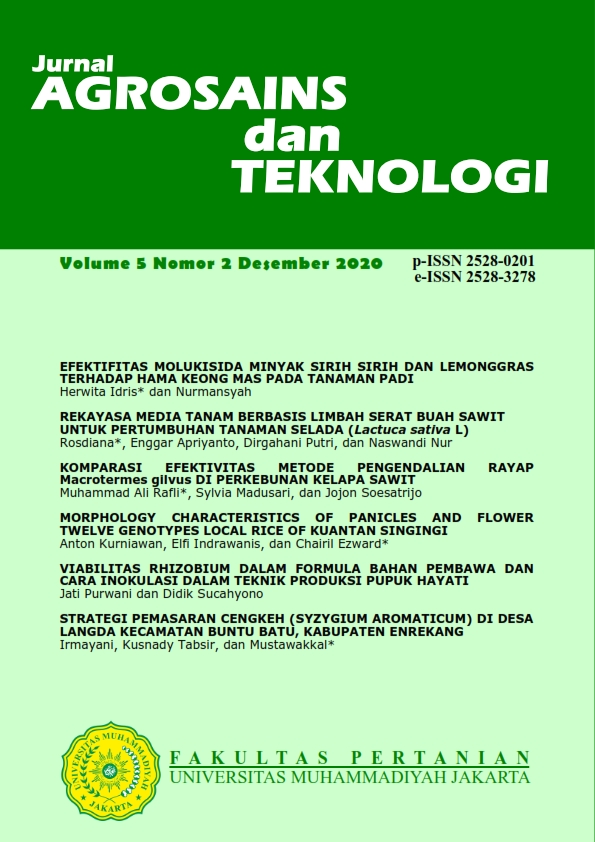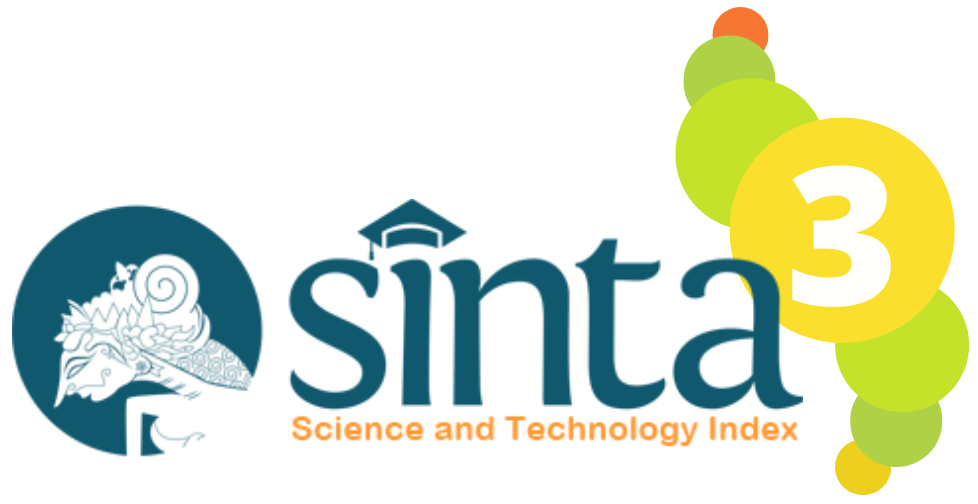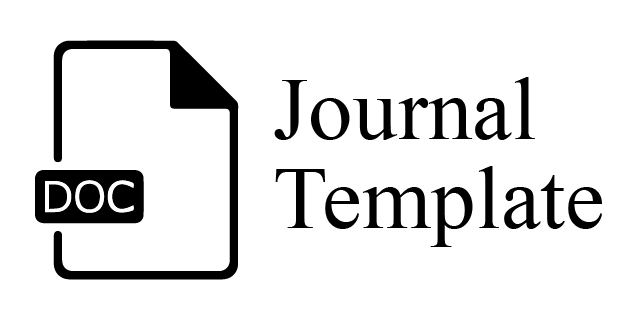VIABILITAS RHIZOBIUM DALAM FORMULA BAHAN PEMBAWA DAN CARA INOKULASI DALAM TEKNIK PRODUKSI MASSAL PUPUK HAYATI
DOI:
https://doi.org/10.24853/jat.5.2.99-108Kata Kunci:
bahan pembawa, teknik produksi, populasi, RhizobiumAbstrak
ABSTRAKTanaman kedelai dapat memfiksasi nitrogen dengan bantuan bakteri bintil akar yaitu bakteri Rhizobium sp. Pemanfaatan Rhizobium sp sebagai inokulan pupuk hayati sangat mendukungpeningkatan produktivitas kedelai. Inokulasi biji kedelai dengan Rhizobium spdapat membantu penyediaan N tanah untuk kedelai. Formula pupuk hayati yang terdiri atas 6 konsorsia isolat Rhizobium sp telah diuji di beberapa lokasi pada tanah masam menunjukkan hasil yang positif, sehingga untuk pengembangannya perlu dilakukan “produksi massal”. Penelitian teknik produksi massal dilakukan di “Pilot Plant Produksi Pupuk Hayati” Balai Penelitian Tanah di Bogor. Penelitian disusun dengan rancangan acak lengkap, perlakuan terdiri atas kombinasi antara cara inokulasi dan pengemasan dengan formula bahan pembawa. Perlakuan terdiri atas delapan kombinasi perlakuan diulang tiga kali. Pertumbuhan sp sebelum diinokulasi ke dalam bahan pembawa diamati. Hasil penelitian menunjukkan bahwa isolat Rhizobium sp yang digunakan mempunyai fase pertumbuhan berkisar antara 4–48 jam. Populasi Rhizobium dalamformula pupuk hayati yang diinokulasi ke dalam bahan pembawa Biochar+Gambut mampu mempertahankan populasi Rhizobium tertinggi hingga masa simpan 6 bulan dibandingkan perlakuan lainnya. Populasi Rhizobium pada perlakuan tersebut sebanyak8,13 log CFU.g -1 . Sedangkan populasi inokulan Rhizobium sp dalam pupuk hayati yang diinokulasikan menggunakan mesin injektor dengan bahan pembawa Biochar sebanyak 7,66 log CFU.g -1 .ABSTRACTSoybean plants can fix nitrogen with the help of root nodules bacteria, namely Rhizobium sp. The use of Rhizobium sp as an inoculant of biofertilizers supports to increase the productivity of soybean. Inoculation Rhizobium sp of soybean seeds helps to provide soil N for soybeans. Biofertilizer formula consist of six consortia of Rhizobium sp had been tested in more locations on acid soils showed positive results, so for it’s development for biofertilizer it is necessary to do "mass production", was conducted at the "Biofertilizer Production Plant Pilot" of Indonesian Soil Research Institute. The study was arranged in a completely randomized design, the treatment consist of ways of packaging methods and the carrier formula. The treatment consisted of eight combinations repeated three times. Rhizobium sp growth before inoculation into the carrier was observed. Rhizobium population in the formula of biofertilizer which is inoculated into the Biochar+Peat carrier and then packaged by packaging machine is able to maintain the highest Rhizobium population up to a shelf life of 6 months compared to other treatments,. Rhizobium sp population in this treatment was 8.13 logCFU.g -1 . While the population of Rhizobium sp inoculants in biofertilizers inoculated using an injector with Biochar carrier as much as 7.66 log CFU.g -1.Referensi
Mohamed ASA, Adel Kamal Khider AKA and Sekaran M. 2016. Effect
of storage Temperature, Duration and Types of Biofertilizer Carriers
on Survival and Numbers of Bacterial Strains Bacillus megaterium var. phosphaticum , Azotobacter chroococcum, Rhizobium leguminosarum and Transformant, Transconjugant B. megaterium var. phosphaticum
Asie ER. 2005. Nodulasi dan Hasil Kedelai Akibat pemberian Pupuk
Hayati dan Bahan Organik Berbeda Waktu Pengomposan. Agrivita . 27 (1) : 7-13
Bashan Y and Holguin G. 1997. Azospirillum – Plant Relationship : Environmental and Physiological Advances. Can. J. Microbiol. 43:103-121.
Bashan Y . 1998. Inoculants of plant growth-promoting bacteria for
use in Agriculture. Biotechnol Adv 16:729–770
Bhattacharyya P, Singh T (1992). Simplified methods of mass production and application of biofertilizer. Proc. Natl. Sem. Organic farming. Edited by Rai MM, Verma LN, JNKVV and IGKVV, Indore, India, pp. 166-
Behl RK, Sharma H, Kumar V and Narula N,” Interactions amongst
mycorhiza, Azotobacter Chroococcum and root characteristics of wheat varieties” J. Argon. Crop Sci. Vol 189,
, pp 151-155.
Brahmaprakash, G.P.; Girisha, H.C.; Vithal Navi.; Laxmipathy, R.; Hegde, S.V.: ‘Liquid Rhizobium inoculant formulations to enhance biological nitrogen fixation in food legumes’. Journal of Food Legumes. 20, pp. 75–79, (2007)
ISI (1986). Indian standard specification for Rhizobium inoculants.
Standard: IS 8268-1986.
Jauhari KS (1988). Dilution optima of broth cultures for maximizing
production of carrier bbased inoculants. Curr. Sci. 57: 507-
Jauhari KS, Subba Rao NS (1984) Simple glass fermentor
for Rhizobium culture production. Curr. Sci. 53: 984- 985.
Kannaiyan S, “Biofertilizers for sustainable crop production. .In:
Kannaiyan. S (ed) Biotechnology and biofertilizers”Kluwer Academic Publishers, Derdrecht, The Netherlands, 2002, pp 9-49
Kementerian Pertanian 2010. Rencana Strategis Kementerian Pertanian
Tahun 2010-2014.
Kumar V, Behl RK and Narula N ,” Establishment of phosphate
solubilising strains of Azotobacter cChroococcum in
the rhizosphere and their effect on wheat cultivars under
greenhouse conditions,” Microbiol. Res.vol 156, 2001, pp 87-93.
Mishra BK, Dadhich SK (2010). Methodology of nitrogen
biofertilizer production. J. Adv. Dev. Res. 1: 3-6.
Simanungkalit RDM, D.A. Suriadikarta, R. Saraswati, D. Setyorini, dan
W. Hartatik, Pupuk Organik dan Pupuk Hayati. Bogor: Balai
Besar Penelitian dan Pengembangan Sumberdaya Lahan Pertanian (2006).
Simarmata TR. Hindersah. 1999. Optimalisasi Aplikasi Pupuk
Biologis untuk Meningkatkan Produktivitas Lahan Menuju Pertanian Berkelanjutan. Prosiding Kongres Nasional VII HITI, Bandung. p 729-736.
Smith RS. 1992. Legume inoculant formulation and application’.
Canadian Journal of Microbiology. 38, pp. 485–492.
Somasegaran P, Hoben HJ (1985). Methods in legume Rhizobium
technology. NifTAL, MIRCEN, Univ. Hawaii, Paia, USA, p. 367
Somasegaran, P. and H.J. Hoben. 1994. Handbook for Rhizobia.
Springer-Verlag, New York. Sulistyowati CA (2002). Can Organic
Agriculture Help Farmers? The Jakarta Post, Monday September
, p.7.
Xavier I.J, Holloway G, Leggett M. 2004. Dvelopment of Rhizobial
inoculants formu-lation. Doi : 10-1094/CM-2004-0301-06-RV.
http: www.plantmanagent net work.org/pub/m/review /2004/
develop/.Accessed 17 Maret 2013.










